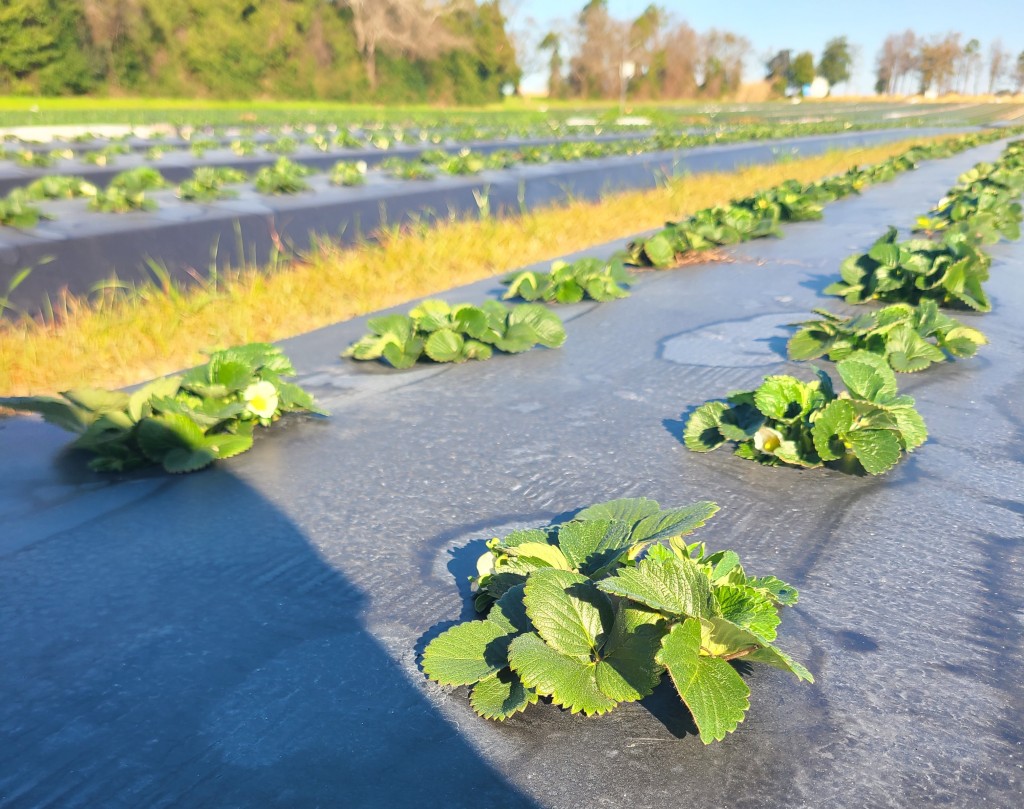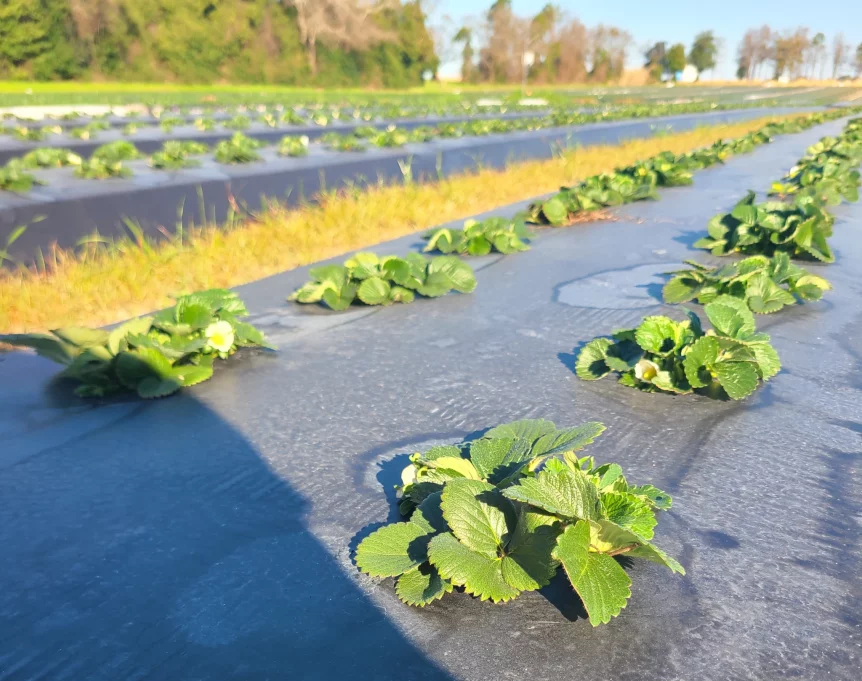
Clemson Extension agents provide updates in The South Carolina Grower this week about the status of various crops being produced throughout the state.
Midlands
Phillip Carnley
- Strawberries are looking good around the Midlands. The biggest issue I’ve seen is still Neopestalotiopsis and getting plants to size up. With Neopestalotiopsis, stay on top of a preventative spray with thiram or Switch. If plants are still small, row covers are your friend and will help force crown development. Make sure prior to covering that plants are free of spider mites and disease. Easter comes early this year, and growers are eager to meet that Easter rush for berries. Be mindful of the growth stage of your plants and previous weather history so as not to set yourself up for failure. There is some leafspot lingering around, but nothing too major so far. And as always, deer are still a major concern and have been seen feeding in some of the higher populated areas.
- Blueberries are ahead this year in development and are starting to bud and bloom in the Midlands. There is a lot of cane dieback from cane blight and winter tenderness from late applications of nitrogen, but overall health looks good.
- Leafy greens are still producing very well. Mustard, depending on the age of the planting, is bolting frequently. Turnips and rutabaga have played out recently, and a few growers are using them as a green manure.
- Peaches are being pruned and seem to have put on great new growth for the season. Some orchards are still being ripped out and replanted.
- Onions are growing nicely for those who planted. Make sure to keep an eye out for any leaf spot that may be present and carefully manage fertility. If curing and shelf life of onions has been a problem in the past, look at your late-season fertilizer applications. A fast-growing plant is susceptible to rot and has a shortened shelf life. Prior to harvest, pull back on fertility.
Rob Last
- Brassica transplants are in the Midlands, with early establishment looking good. Remember to inspect plants closely for signs of black rot and discard transplants displaying symptoms; there is no effective treatment.
- Lettuce transplants are also going in.
- Strawberries are beginning to be fertigated. Remember to start at seven pounds of nitrogen per week or one pound per day. Check out the fertigation calculator to help with fertilizer calculations.
- Some strawberry crops are being covered to begin bloom protection. When covers come off, inspect carefully for mites. I see the odd two-spotted spider mites in covered crops. Mite populations can quickly flare under covers. When you need to treat, use a specific miticide, not a pyrethroid, to avoid further flare-ups in the population.
- I am getting questions about crystallized liquid fertilizer. Liquid fertilizer will crystalize (salt-out) with reduced temperatures. The exact temperature can depend on the source materials in the fertilizer and the specific analysis. Crystallization is more likely to occur with cold-processed fertilizers as opposed to warm-process manufacturing. The crystallization can lead to clogging of emitters or blocking pumps. However, the crystals contain nutrients that we need, so what can we do?
- Storage: Try to avoid storing liquid fertilizer over winter if possible. If the material has to be stored, try to insulate the tanks or move them into a protected environment.
- Agitation: It may help to get the solids back into solution and ease the problem.
- Could you wait until the material warms up to re-agitate the fertilizer solution? For small areas, dispense the concentrate into a bucket and try to mix it with warm water over 75 degrees Fahrenheit. The higher temperature can improve solubility and agitate the mix aggressively. Try only to do this with enough material for the application.
Sarah Scott
- We’re starting to see some pink around Edgefield County. Peach trees have started the early stages of bloom. Looking back on pictures from last year, we seem to be about 7-10 days behind where we were last year, which is good. Growers are putting out chlorpyrifos with oil sprays.
- We are seeing white peach scale in more trees than usual this year, which could be caused by timing of sprays or potentially the gap in chlorpyrifos use over the past couple of seasons.
Pee Dee
Brittney King
- The Pee Dee had some cold night temperatures over last weekend, with Sunday night getting down to 32 degrees Fahrenheit. Later this week, we are in for some warmer weather, so now is the time for strawberry growers to check and/or spray their fields for spider mites. Damage that occurs before the strawberry begins fruiting has the biggest impact on yield, so it is important to protect the plants during the early bloom stages. Think about using miticides that won’t hurt predatory mite populations. Nealta, Acramite and Agri-Mek are a few that have been shown to work with predatory mites. Nealta and Acramite also have activity against both eggs and nymphs/adults. Refer to the 2024 Strawberry IPM Guide (pages 33-36) or the MyIPM App for a full list of recommended miticides for conventional and organic systems.
- Rutabagas, turnips and leafy greens are looking good. Garlic and onions should get some good vegetative growth from the warmer weather later this week.
Upstate
Andy Rollins
- Upstate strawberry plants are beginning to push some blooms. Initial plant problems with Neopestalotiopsis from multiple farms with same original plant source were diagnosed earlier this year. Plant death does not appear to be continuing past the first two months after planting, but major losses have already occurred. Cooler weather along with treatments may have slowed progression through the winter. New blooms coming now need to be protected with fungicides like thiram and captan regularly.
- We are beginning fertilization slowly with a half pound of nitrogen per day with a weekly injection of 3.5 pounds of nitrogen per week. When we get a new flush of leaves coming out, I would encourage growers to collect 30 new leaves including the petioles (stems at base of leaflets). The leaflets need to be sent in for an orchard leaf sample and the petioles need to be sent in for just nitrate.
- I have found spider mite eggs and adults on many farms. The threshold on these is very low. Please make sure to treat them when you find them on the bottoms of the leaves with a 10x magnification lens. Many egg-killing products (Acramite, Kanamite) ask on the label to be used alone. Some others can be mixed with other products. Just read the labels and make sure you are treating what you are finding.
- Lastly, when plants have an average of 3 to 4 blooms per plant, this is an economic loss if these are killed. Consider protecting at this point. Any temperatures below 30 degrees Fahrenheit can kill blooms. Just make sure you remove the covers before warm weather pushes out all your blooms at one time.
- Peach-wise, many are putting out oil sprays, many of at least 2% concentration of dormant oil (mineral oil). Lorsban products can be purchased again and many have been able to find some supplies, although limited. Those that were able to purchase it are using one quart per acre rates with the oil and putting in 2 to 4 pounds of various copper formulations. As we progress into delayed dormant, we will need to be more cautious on oil and copper concentrations. Brett Blaauw’s (UGA entomologist) work suggests that Sevin liquid is very effective at controlling scale at a one gallon-per acre rate, but only in the delayed dormant time period, which we are not quite at. I am seeing some bud movement on peach but only in certain early varieties.
- Blueberry and blackberry buds are moving, especially in earlier varieties. Many farms are working on weed control programs and finishing up pruning operations.










